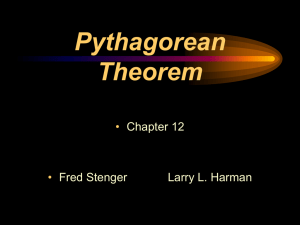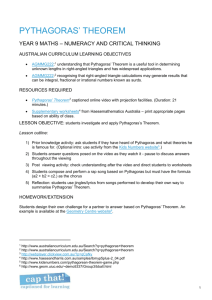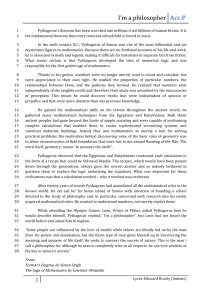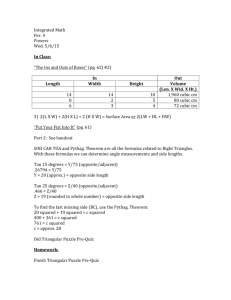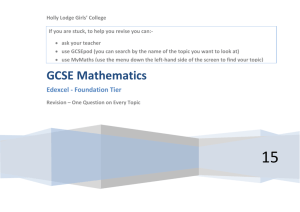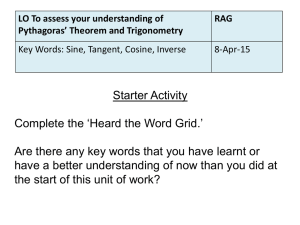Mathematics Grade 5 Pythagoras` Theorem Lesson Plan
advertisement
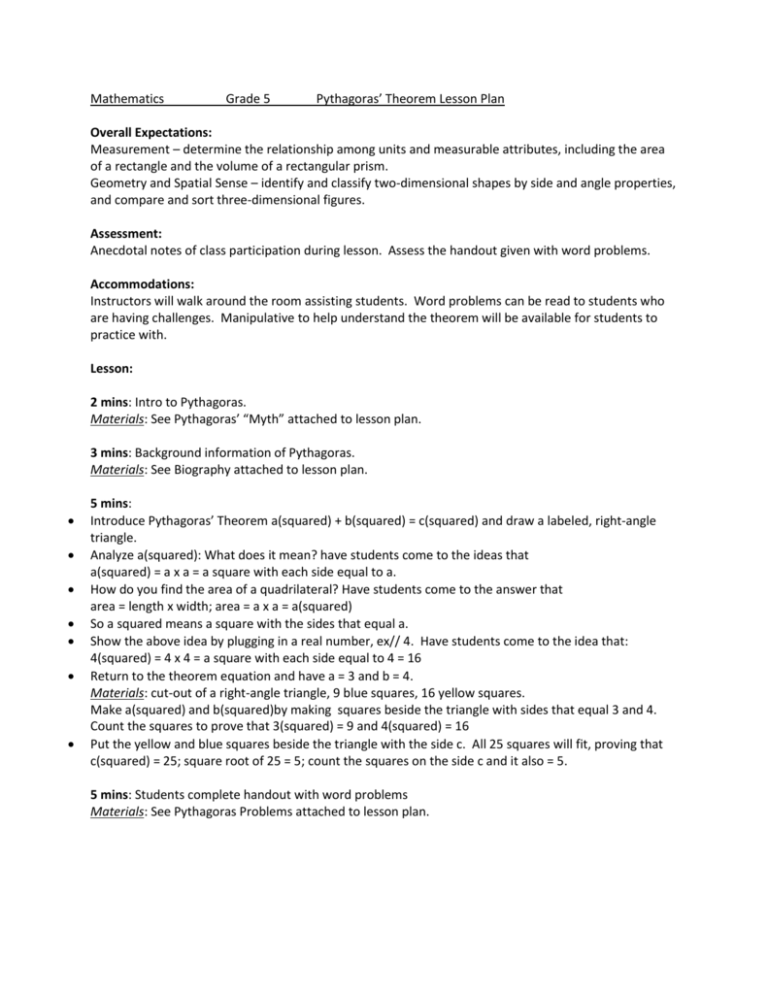
Mathematics Grade 5 Pythagoras’ Theorem Lesson Plan Overall Expectations: Measurement – determine the relationship among units and measurable attributes, including the area of a rectangle and the volume of a rectangular prism. Geometry and Spatial Sense – identify and classify two-dimensional shapes by side and angle properties, and compare and sort three-dimensional figures. Assessment: Anecdotal notes of class participation during lesson. Assess the handout given with word problems. Accommodations: Instructors will walk around the room assisting students. Word problems can be read to students who are having challenges. Manipulative to help understand the theorem will be available for students to practice with. Lesson: 2 mins: Intro to Pythagoras. Materials: See Pythagoras’ “Myth” attached to lesson plan. 3 mins: Background information of Pythagoras. Materials: See Biography attached to lesson plan. 5 mins: Introduce Pythagoras’ Theorem a(squared) + b(squared) = c(squared) and draw a labeled, right-angle triangle. Analyze a(squared): What does it mean? have students come to the ideas that a(squared) = a x a = a square with each side equal to a. How do you find the area of a quadrilateral? Have students come to the answer that area = length x width; area = a x a = a(squared) So a squared means a square with the sides that equal a. Show the above idea by plugging in a real number, ex// 4. Have students come to the idea that: 4(squared) = 4 x 4 = a square with each side equal to 4 = 16 Return to the theorem equation and have a = 3 and b = 4. Materials: cut-out of a right-angle triangle, 9 blue squares, 16 yellow squares. Make a(squared) and b(squared)by making squares beside the triangle with sides that equal 3 and 4. Count the squares to prove that 3(squared) = 9 and 4(squared) = 16 Put the yellow and blue squares beside the triangle with the side c. All 25 squares will fit, proving that c(squared) = 25; square root of 25 = 5; count the squares on the side c and it also = 5. 5 mins: Students complete handout with word problems Materials: See Pythagoras Problems attached to lesson plan. Pythagoras “Myth” Once upon a time, a long time ago, there was a man named Mnesarchus and a woman named Parthenis. They were husband and wife. Mnesarchus was a merchant and had business ties in Delphi. There he went from his home in Syria with his wife as his companion. Once their business obligations were fulfilled, they decided to visit the oracle of Delphi to speak to the Pythian priestess and consult her as to whether the Fates would be in their favour for their long journey home. The prophetess, in all her glory, beauty and wisdom, seated herself upon the golden tripod above the yawning vent of the gods. There she listened to the divine message communicated through her. She did not respond with the answer the couple were seeking. Instead, in all her knowing, she told them that Parthenis was with child and that this child would be a son destined to surpass all men in beauty and wisdom. “Throughout the course of his life your yet-to-be-born child will contribute much to the benefit of humankind. He will not be regarded as a mere mortal – he will be considered a god taking human form enabling him to come to the world and instruct the human race”, she said. “He will be deemed a sage and saviour.” Upon hearing this news Mnesarchus and Parthenis were overjoyed. The pair were very deeply moved by this prophesy from the Pythian priestess. “From this time forward I will be called Pythais in your honour”, said Parthenis to the holy woman seated before them. When it came to pass that the child was born at Sidon in Phoenicia, it was, as it was prophesied, a boy. Mnesarchus and Pythais called the child Pythagoras, for they believed he had been predestined by the Pythian priestess at the great oracle of Delphi. Adapted from “Secret Teachings of All Ages: The Life and Philosophy of Pythagoras” http://www.sacred-texts.com/eso/sta/sta15.htm http://www-gap.dcs.st-and.ac.uk/~history/PictDisplay/Pythagoras.html BIO: Pythagoras of Samos is often described as the first pure mathematician which basically means that he was not set out to solve particular mathematical problems, but studied math for the sake of knowing more about it. He was very interested in numbers, triangles and the idea of a proof for theories. We know very little about his mathematical achievements because the society that he led, half religious, half scientific followed a very strict code of secrecy. To this day much of his work is shrouded in mystery, and many ancient biographies describe him as a god-like figure. Many strange legends have been preserved concerning the birth of Pythagoras. Some maintained that he was no mortal man: that he was one of the gods who had taken a human body to enable him to come into the world and instruct the human race. Born to father, Mnesarchus and mother, Pythais, Pythagoras was born in approximately 570BCE (Before Common Era) on the Greek island of Samos and died around 475CE (94 years old!!) Pythagoras founded a philosophical and religious school in Italy called the Semicircle which had many followers. Of which he gathered a small group of sincere disciples and taught them the fundamentals of mathematics, music and astronomy (which you’ll hear more about soon) which he considered to be the triangular foundation of all the arts and sciences. Pythagoras was the first to use the term philosopher. Before him, wise men called themselves sages, meaning those who know. But he preferred philosopher, meaning one who is attempting to find out. When he was about sixty years old, Pythagoras married one of his disciples, and had seven children. The stories of how he died vary, but it is believed that he was trapped and burned alive in his school, by those who set it ablaze because they did not appreciate his teachings. Pythagoras studied odd and even numbers and believed that each had its own personality - masculine or feminine, perfect or incomplete, beautiful or ugly. He developed the theorem of Pythagoras, which most of us know today which proves that for a right angle triangle the square on the hypotenuse is equal to the sum of the squares on the other two sides. This theorem was known to the Babylonians about 1000 years before pythagoras’ time, but he was the first to prove it. He taught that everything in nature was divisible into three parts and that you were not truly wise unless you could see every problem as being systematically triangular. The Pythagorean Theorem Math Problems You are helping to build a brand new inner city school; the building is 10 metres tall. You need to find a ladder to climb to the top of the building. You will place the ladder 5 metres from the base of the building. How tall must your ladder be? 10 m 5m You are visiting several schools for interviews. You know that School A is 4 km from School B and School B is 9 km from School C. What is the distance between School A and School C? C A B You need to pick up some supplies for next week’s art lesson, but you need to find the quickest route possible. You need to go to the hardware store and art supplies store. Is it shorter to go to hardware store then the art store OR the art store first then the hardware store? Hardware store 5 km 10 km Your house 5 km B Art Store

